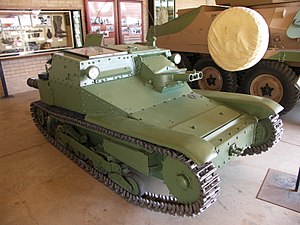| Carro Armato L3/35 | |
|---|---|
 L3/35 displayed at the South African National Museum of Military History (without machine guns). | |
| Type | Tankette |
| Place of origin | Kingdom of Italy |
| Service history | |
| In service | 1 October 1935 – Unknown (Afghanistan) |
| Used by | Kingdom of Italy and others |
| Wars | |
| Production history | |
| Produced | 1935–1938 |
| No. built | 1,200 L3/33; 1,300 L3/35 |
| Variants | L3/33, L3/38, L3 cc, L3 Lf, |
| Specifications | |
| Mass | 3.2 tonnes (3.1 long tons; 3.5 short tons) |
| Length | 3.17 m (10 ft 4+3⁄4 in) |
| Width | 1.4 m (4 ft 7+1⁄8 in) |
| Height | 1.3 m (4 ft 3+1⁄8 in) |
| Crew | 2 (commander and driver) |
| Armour | 6–14 mm (0.24–0.55 in) |
Main armament | 2 × 8 mm (0.31 in) machine guns |
| Engine | FIAT-SPA CV3 water cooled 43 hp (32 kW) |
| Suspension | bogie |
Operational range | 125 km (78 mi) |
| Maximum speed | 42 km/h (26 mph) on road |
The L3/35, also known as the Carro Veloce CV-35, was an Italian tankette that saw combat before and during World War II.[1] It was one of the smallest tanks that faced combat.[citation needed] Although designated a light tank by the Italian Army, its turretless configuration, weight and firepower make it closer to contemporary tankettes. It was the most numerous Italian armoured fighting vehicle and saw service almost everywhere the Italians fought in the Second World War but proved inadequate for modern warfare, having too thin armour and weak armament of only machine guns. It was cheaply produced but because of its light armaments and armour it was reserved to mostly colonial, policing, reconnaissance, and supply duties. However, given its low production costs, proved to be efficient in the Second Italo-Abyssinian War, Spanish Civil War and the Greco-Italian War where it provided reliable support to Italian infantry and disrupted enemy lines.[1][2]
- ^ a b "Carro Veloce L3/35 (CV-35)". www.tanks-encyclopedia.com. Retrieved 5 December 2021.
- ^ Hansen, Robert (24 February 2019). "CV 33 (L3 33) & CV 35 (L3 35) Tankette". Comando Supremo. Retrieved 5 December 2021.